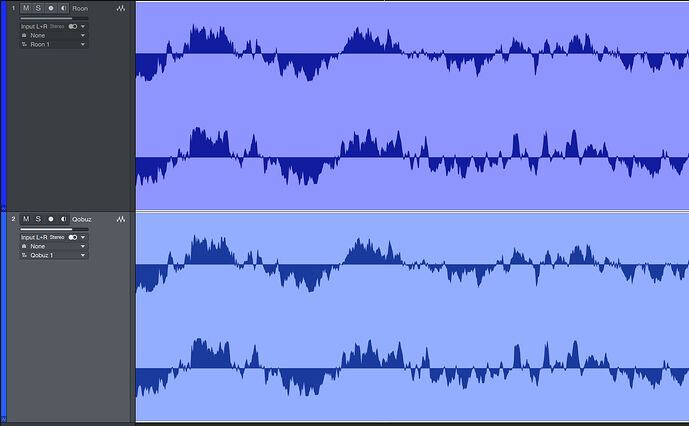Just remember it doesn’t sound as good,but it has a great UI!
That’s not what I said.
I did a test comparing the Naim and Roon apps a few months ago when there was much debate about which sounded better when streaming Qobuz tracks. I have repeated it today using Qobuz Connect and Roon with the same methodology.
Streamer/Amp: Naim Uniti Nova
Audio Interface: Focusrite Scarlett 2i2
DAW: Studio One 7 Pro
Headphones: beyerdynamic DT 900 PRO X studio headphones
Track: The The, Cognitive Dissident
Bit rate/depth for playback and recording: 96/24
Method:
- Record the track from Roon and Qobus on separate audio tracks in S1 Pro.
- Compare waveforms, which as can be seen from the image below, are identical.
- A/B the audio by simultaneously playing both tracks, switching back and forth from one to the other. You cannot tell that it is being switched, it sounds like a continuous stream.
N.B. Unlike my previous test, I did not have to normalise the waveforms, the levels are the same.
I don’t doubt other peoples’ experiences which are different to these findings, they could be attributed to variances in the implementation of Roon and Qobuz Connect on different hardware, but on my system, there is clearly no advantage in either, so for me it’s down to UI preference.
My previous test comparing the Naim and Roon apps: So Long Roon - #59 by Nick_Cassidy
Antidotally, I briefly listened to qobuz via Roon versus Qobuz Connect in my system (Nuc 13i7 > Auralic Aries G1.1 > Holo May Dac) and found that QC maybe, perhaps, could have sounded very slightly more focused/clear? But the difference was subtle at best, and I decided to not spend any more time exploring this. For me, this confirmed that they sound similar enough to not worry about it for now.
Well said!There are many variables but one we all share….listening environment!!!
Cool.
Now align them, invert the phase of one to cancel out the other and see if there is anything audible.
What sounds better or best, is up to the individual to decide through direct experience. Given we are rarely listening to the exact same sound system, much less in the same room, or the same ears, or with the same sensitivities means arguing which sounds best is pointless.
One advantage Qobuz Connect has over Roon is it eliminates one computer like device from the audio chain. The Roon Server has to run on something (computer, NUC, etc). It then sends the audio from that Server to an endpoint. Qobuz Connect (and Tidal/ Spotify) skips the entire Server step and instead runs directly from your endpoint (streamer, etc). The device a Roon Server runs on is invariably a noisy affair. It’s the elimination of all that noise that gives the Connect feature a potential sonic advantage.
Whether or not there is an actual sonic advantage is for you to decide. With so many variables involved, there is no universal answer. It’s like arguing about which ice cream flavor tastes best. Try it and see.
Hmm, I used to think shorter paths are/were better, and to a certain extent I still do (a little), but… if I eliminate my HQPlayer computer and the NAA, I feel like it’s a disadvantage…
No argument there, it’s Cherry Garcia! ![]()
Interesting comments regarding noise. My own understanding of it is that, until it hits the renderer, there’s no “audio” per se, just digital data. Thus noise should not really be relevant.
I’ve been in the hifi hobby for longer than I care to remember and whilst I acknowledge that some may “hear” differences in a variety of circumstances, I generally do not (beyond speakers, amps and some sources).
One thing I do find, let’s say distracting, is folk who use graphs and measurements in this arena. I have never, and will never comment on specs, graphs or the like. For me this is all about and only about listening to the music.
My network topology is quite complex, yet the position of my Roon server in it has changed multiple times to absolutely zero audible difference (for me at least).
Horses for courses of course. I obsess about completely unrelated issues!
Vice versa, the streaming download and FLAC unpacking has to happen somewhere and if it doesn’t run on the Roon Server, it runs directly on the endpoint next to the DAC.
That’s a minor issue compared to the noise generated by a computer or NUC. They are buzz saws.
A case could be made that HQPlayer primarily ameliorates the noise sins of the computer. Vinyl needs not such things.
In the server it’s digital data, so it matters just as little as for all data transfers, i.e., not at all. The only place where EMI could possibly have an influence is in the DAC (and in reality it doesn’t really, either, if it’s competently designed. But IF one wanted to minimize EMI and keep computer noise away, it would be close to the DAC and maybe amps).

The only streamer that I currently possess which supports both Roon Ready and Qobuz Connect is my WiiM Ultra. My Cambridge CXN V2 and Bluesound Node X only have Roon Ready.
I can’t hear a difference between feeding my WiiM the same tracks using either Roon Ready or Qobuz Connect.
I’ll be sticking with Roon for sure ![]()
Ok, you got me. There is a very slight audible sound, not complete silence. But very close.
That’s very interesting. It also confirms my findings ![]()
Could they just be out of alignment by a couple of frames? That would create this
You have a Roon or Qobuz streamer/endpoint somewhere on your LAN – let’s assume on ethernet for the sake of argument. You also have multiple computers and random IoT devices on the same LAN, as well as ethernet switches and a router (which is really a computer). Why would the Roon server make much/any difference in electrical noise in such a setup? Either with Roon or Qobuz, digital packets travel over your LAN from a source (router or Roon server) to a destination (streamer/endpoint) over ethernet cables and switches. What is the technical argument that such digital packets are “cleaner” coming from one source vs the other?
OTOH, the running code and data path inside your streamer is different between Roon and Qobuz, and potential bugs/design flaws may be different between the two paths. If there are any objective differences (through instrumentation or blind A/B testing), that’s where you should be looking.
